
Addition, Multiplication, Division, and Composition of Linear Functions
by Michael Walliser
Consider any two functions f(x) = ax + b and g(x) = cx + d. In this assignment we will examine the following resultant functions:
h(x) = f(x) + g(x)
h(x) = f(x)g(x)
h(x) = f(x)/g(x)
h(x) = f(g(x))
Before we assign values to the constants and look at the graphs, let's perform these binary operations algebraically and think about what we should expect.
For the operation of addition, we will have h(x) = f(x) + g(x) = (ax + b) + (cx + d), or after regrouping, h(x) = (a + c)x + (b + d). Thus, we can expect a linear function with slope a + c and y-intercept b + d.
For the operation of multiplication, we will have h(x) = f(x)g(x) = (ax + b)(cx + d), or after expanding, h(x) = acx2 + (ad + bc)x + bd. Thus, we can expect a quadratic function, where the sign of ac will determine whether the parabola opens up or down.
For the operation of division, we will have h(x) = f(x)/g(x) = (ax + b)/(cx + d). Since we have an x term in the denominator, we have an inverse function, so we can expect the graph to be a hyperbola. A vertical asymptote will exist where the denominator is equal to zero, i.e. where cx + d = 0, or x = -d/c. Since the numerator and denominator are of equal degree (1), we can predict the horizontal asymptote by computing the ratio of leading coefficents, i.e. y = a/c. If this ratio is positive, the hyperbola will exist in quadrants I and III (relative to the asymptotes), and if it is negative, it will be in quadrants II and IV (again, relative to the asymptotes).
Note: "relative to the asymptotes" means "quadrant I" is above the horizontal asymptote and to the right of the vertical asymptote, and so on.
For the operation of composition, we will have h(x) = f(g(x)) = a(cx + d) + b, or after regrouping, h(x) = acx + (ad + b). Thus, we can expect a linear function with slope ac and y-intercept ad + b.
Let's now assign arbitrary values to our constants and check the accuracy of our predictions. For the first examination, we will use a = 2, b = 1, c = -4, and d = 3. Thus, we have f(x) = 2x + 1, and g(x) = -4x + 3, as shown below.

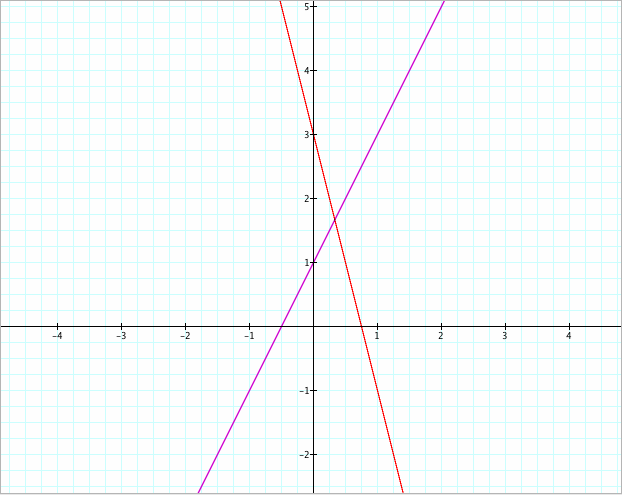
The first binary function we will look at is addition, where h(x) = f(x) + g(x), as shown below.
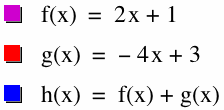
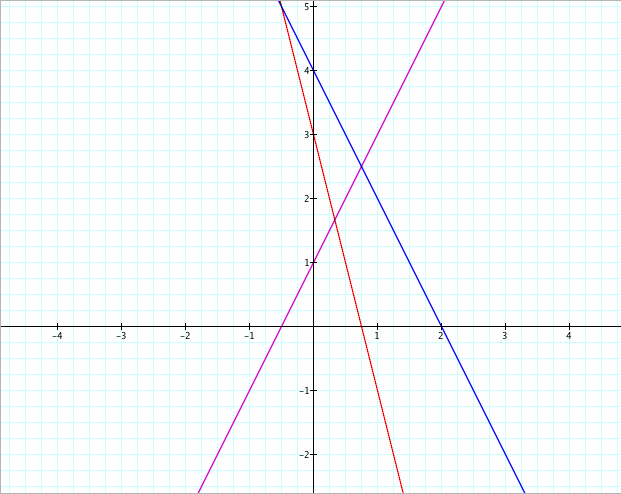
Adding the two functions, we get another linear function h(x) = -2x + 4. We see that the slope of the curve of h(x) is -2 and the y-intercept is 4. Remember that our prediction was that the slope would be a + c = 2 + -4 = -2 and the y-intercept would be b + d = 1 + 3 = 4, so the prediction was correct. Note that for any value of x, we can add the y values of the purple and red curves (f and g) and get the value of the blue curve (h).
Next we will examine multiplication, i.e. h(x) = f(x)g(x). Remember that we are expecting a quadratic function, and since ac = -8 < 0, the parabola should open downward. Let's have a look:
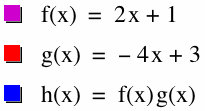

We see that our prediction was correct. We should also note that the roots of the quadratic function are the roots of each of the linear functions. Since a product is equal to zero if and only if one of the factors is equal to zero, this result should not be surprising.
Next, let's look at the operation of division, where h(x) = f(x)/g(x) = (2x + 1)/(-4x + 3). We expect the graph to be a hyperbola with a vertical asymptote at x = -d/c = 3/4. Now let's see what we get:
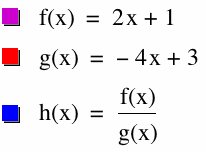
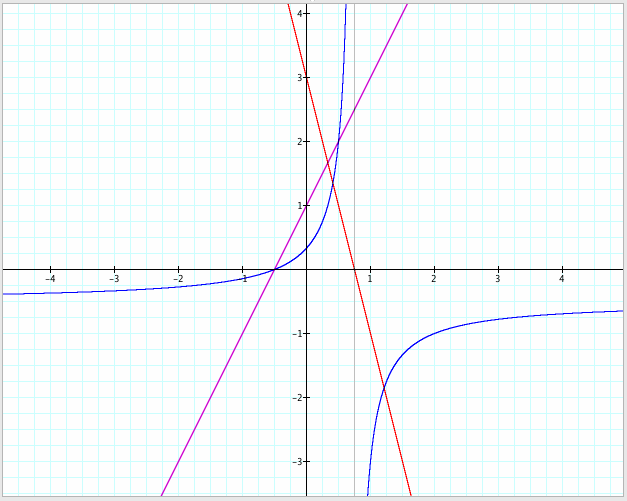
The graph is as predicted. The vertical asymptote is at x = 3/4. Note that this coincides with the root of the denominator function g(x) = -4x + 3. The horizontal asymptote is at y = -1/2, which is equal to the ratio of leading coefficients a/c = 2/(-4) = -1/2. We know that any fraction equals zero if and only if the numerator is equal to zero, so the root of our quotient unsurprisingly coincides with the root x = -1/2 of the numerator function f(x) = 2x + 1. Finally, if we view the asymptotes as axes, we see that the hyperbola exists in quadrants II and IV, which is consistent with our negative ratio of leading coefficients.
Next, we will look at the composition of the two functions, h(x) = f(g(x)) = 2(-4x + 3) + 1 = -8x + 7. Recall our prediction of a linear function with slope ac = 2(-4) = -8 and y-intercept ad + b = 2(3) + 1 = 7. Our equation for h(x) certainly matches our prediction, but let's look at the graph.


Sure enough, the function h(x) = f(g(x)) is linear with slope ac = -8 and y-intercept ad + b = 7, just as predicted using algebra.
We have used algebra to predict the results of these binary operations, and using specific linear functions, we showed that our predictions held up. Now let's vary the functions and see if the properties we came up with still hold. Let's start by letting a = 3, b = -5, c = 1, and d = -4. To compact the lesson, we will show two resultant functions per graph.
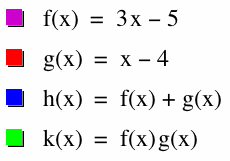

First, we look at the sum h(x) = f(x) + g(x). Our prediction is that the slope is a + c = 3 + 1 = 4 and that the y-intercept is b + d = -5 + -4 = -9. Observing the graph, we see that the prediction is true.
Our prediction for the product k(x) = f(x)g(x) is a quadratic function, and since ac = (3)(1) = 3 > 0, we can expect the parabola to open upwards. We also expect to see roots corresponding to the roots of f(x) and g(x). By simple observation, we can see that our conjectures hold.
Our next graph shows division and composition of the two linear functions.
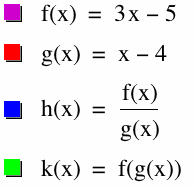
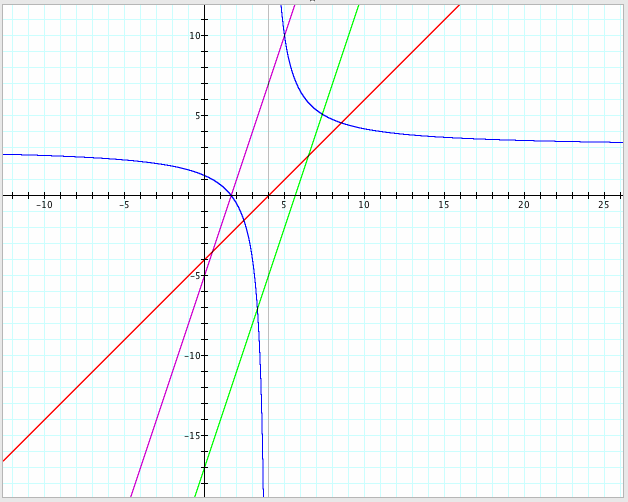
Recall our predictions for the quotient h(x) = f(x)/g(x). We expect a hyperbola with a vertical asymptote at x = -d/c = 4, and a horizontal asymptote at y = a/c. We also predict that the root will coincide with the root of the numerator function f(x) = 3x - 5, and that if we think of the asymptotes as axes, the hyperbola will exist in quadrants I and III. If we observe the graph, we see that all these predictions hold true.
For the composition function, we expected a linear function with slope ac = (3)(1) = 3 and y-intercept ad + b = (3)(-4) - 5 = -17. Again, the predictions hold true.
Now let's look at some special cases. For our quotient, we predict the curve to be a hyperbola with a vertical asymptote at x = -d/c and a horizontal asymptote at y = a/c = 3. So what happens if c = 0? Let's examine:
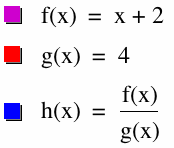

The result is a linear function. Is this what we should have expected? Well, h(x) = f(x)/g(x) = (x + 2)/4 = (1/4)x + 1/2. This is an equation for a line with slope 1/4 and y-intercept 1/2, which is exactly what the graph shows. In general, if c = 0, the quotient h(x) = f(x)/g(x) will reduce to h(x) = f(x)/d, which will yield a line with slope a/d and y-intercept b/d.
Another prediction we made was that the product h(x) = f(x)g(x) produces a quadratic function, and that the sign of ac determines whether the parabola opens up or down. So what if ac = 0? Well, that would mean that either a = 0, c = 0, or both. For these values to equal zero would mean that their graphs are horizontal lines, i.e. constant. So if a = 0 and c = 0, then f(x)g(x) is simply the product of two constants, which yields another constant, and therefore a horizontal line. To see what happens if only one of the two is zero, we will set a = 0 and examine a graph.
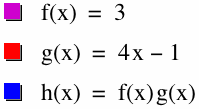
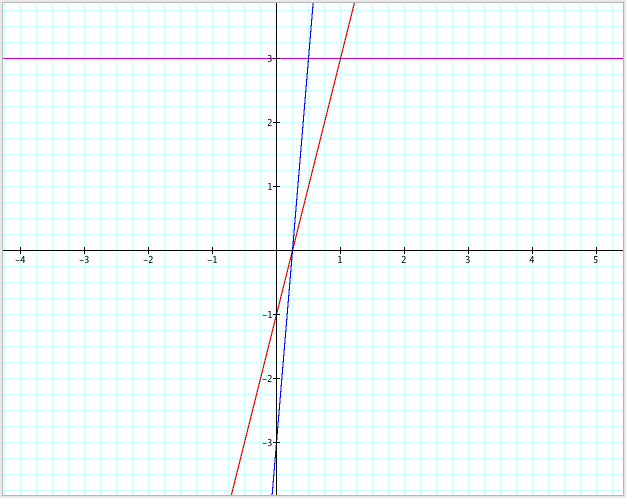
Before we analyze the graph, let's think about the algebra behind it. The product h(x) = f(x)g(x) = 3(4x - 1) = 12x - 3 is a linear function with a slope of 12 and a y-intercept at -3. The slope is equal to bc and the y-intercept is equal to bd. Ultimately, since f(x) is constant, all we really did was multiply g(x) by a constant.